Final report for GNC15-199
Project Information
Despite being commonly persecuted as agricultural pests, native mice may provide important weed seed predation ecosystem services to farmers in row-crop agriculture. A better understanding of the functional role that native mice serve in agro-ecosystems will help inform on-farm management decisions. This study seeks to quantify the ecosystem service potential of native farmland mice throughout the annual cycle in corn and soybean agro-ecosystems.
Cooperators
- (Educator and Researcher)
Research
Prairie deer mice and white-footed mice are morphologically similar and can be difficult to distinguish where populations overlap throughout much of the central United States. Therefore, our first objective was to develop a way to accurately discriminate the two species—a prerequisite for the successful completion of this project. We live-trapped prairie deer mice and white-footed mice within forested and row-crop habitats in central Indiana and used multiplex PCR with species-specific primers to positively determine species identification. We collected a suite of commonly measured external morphological traits (body weight and lengths of ear, hind foot, tail, and body) from each captured animal. Mice were assigned to species based on analysis of DNA and we used discriminant function analysis to identify morphological characteristics that best distinguished the two species. Tail length was the best single discriminator (95.4% discrimination efficiency), with prairie deer mice having shorter tails than white-footed mice. When tail length was used in conjunction with hind foot length, we were able to correctly discriminate 96.8% of individuals in our sample. These results provide simple metrics for field identification of prairie deer mice and white-footed mice in the prairie peninsula region of central Indiana.
Prairie deer mice and white-footed mice are considered ‘generalist’ rodents and display flexibility in their selection of resources in fragmented agro-ecosystems. The influence of forest fragmentation and associated habitat edges differentially affects forest-dependent organisms, particularly when certain species are able to use resources from surrounding matrix habitats. For example, white-footed mice are known to disperse among adjoining farmland habitats, including agricultural matrix, in fragmented agro-ecosystems. However, little is known about explicit spatial variation in population density within adjoining farmland habitats or how this relationship varies seasonally. We explored these questions using spatially explicit capture-recapture models to estimate density of white-footed mice along a gradient of patch (forest fragment) interior to matrix (crop field) interior along fragmented habitat edges. Spatial variation in population density within adjoining habitats was related to the distance from habitat edge, and the magnitude of this relationship (edge effect) varied among seasons and crop cycles within the agricultural matrix. Within-field densities were greater during periods of summer crop growth relative to spring crop emergence or following fall crop harvest. Populations of white-footed mice in forest fragments appear to seasonally spill over from patch habitat into surrounding agricultural matrix, and foraging individuals likely provide seed predation services when seasonally resident row-crop habitats.
Native mice foraging in row-crop habitats must select among a variety of food resources that vary in availability throughout the annual cycle. In particular, understanding how mice select among common agricultural weed seeds and waste grain is important to understand the potential ability of native mice to regulate volunteer crops and weed populations. We evaluated the winter seed preference of deer mice using cafeteria-style feeding trials presented within row-crop fields and used compositional analysis to compare proportional consumption of seeds from 5 common agricultural weeds (common ragweed, common cocklebur, common lambsquarters, velvetleaf, giant foxtail) and 2 grains (corn and soybean) during overnight feeding trials. Prairie deer mice significantly preferred corn to all other available seed types. Ragweed and soybean were also readily consumed and were preferred over seeds other than corn. Giant foxtail was intermediate in preference. These results show that prairie deer mice have clear preferences for certain seeds commonly available in row-crop fields and that mice likely contribute to reduction of waste grain and some weed seed populations.
Seed predation is especially critical in the months of highest seed availability following crop harvest, and is dictated by population density and individual patterns of diet choice. To address this question, we used a combination of mark-recapture demographic and stable isotope dietary analyses to investigate the ecology of prairie deer mice during this critical over-winter period within corn and soybean agro-ecosystems. Winter prairie deer mouse populations were robust in the row-crop habitats we sampled, with densities typically > 13 individuals/ha but variable among trapping grids and throughout winter. Apparent survival of individuals also varied throughout winter (57–79% monthly survival rate), and mean over-winter (December – April) survival of adults was 21%. Winter diets were dominated by waste grain, with corn and soybean contributing 55% and 77% of diet for mice sampled in corn and soybean fields, respectively. Weed seeds contributed less (2 – 27%) to winter diets. Based on our results and published field metabolic rates, we estimate that prairie deer mice remove at least 5.6 kg/ha of waste corn and 6.5 kg/ha of waste soybean seeds during the non-growing season.
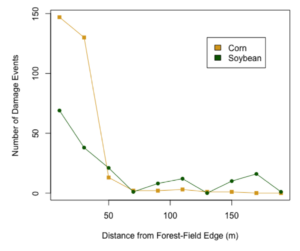
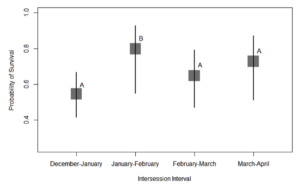
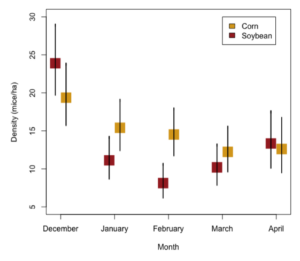
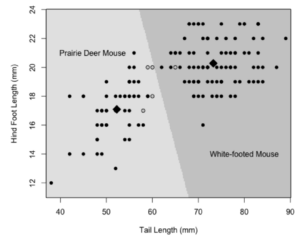
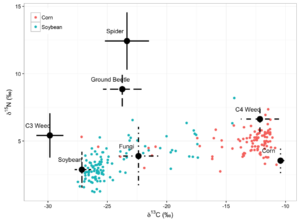
Despite their potential importance as seed predation service providers in fragmented agro-ecosystems, native mice are also known reservoirs for several deadly zoonotic diseases (e.g. hantavirus) and therefore human health (dis)services may outweigh beneficial seed predation services. Hantaviruses are rodent borne pathogens that are the causative agents for hantavirus pulmonary syndrome (HPS) and hemorrhagic fever with renal syndrome (HRFS) in humans. Numerous hantavirus genotypes have been identified (e.g., Sin Nombre virus [SNV]), and their prevalence in rodent host populations varies spatially and temporally. However, comparatively little is known about hantavirus prevalence within rodent populations from the Midwestern United States, where prairie deer mice and white-footed mice are dominant members of rodent communities. We sampled both species in west-central Indiana and tested individuals for presence of hantavirus antibodies to determine whether seroprevalence (% of individuals with antibodies reactive to SNV antigen) differed between species, or among different habitat types within fragmented agro-ecosystems. Prevalence of hantavirus antibodies varied significantly between species, with seroprevalence in prairie deer mice (21.0%) being nearly 4 times higher than white-footed mice (5.5%). Seroprevalence was almost 8 times higher within the interior of row-crop fields (37.7%), where prairie deer mouse populations are syntopic, relative to field edges (5.2%) or adjacent forest habitat (6.1%). Understanding species- or habitat-specific differences in hantavirus prevalence in rodents is important for informing human disease risk and management programs. In particular, despite their important role as seed predators in row-crop habitats, prairie deer mice appear to be a dominant hantavirus reservoir in the fragmented Midwestern agro-ecosystem of this study.
Collectively, our project provides information on the role of native mice (prairie deer mice [Peromyscus maniculatus bairdii] and white-footed mice [Peromyscus leucopus]) as seed predators in fragmented agro-ecosystems. In high-input agricultural systems, capitalizing on ecosystem services is one way to improve the ecological integrity of working landscapes and potentially reduce costs to farmers. Our research documents important seed predation services rendered by native mice in row-crop habitats, particularly during the critical overwinter period when the majority of weed seeds and waste grain are available for consumption following fall seed rain and crop harvest. However, native mice are generalist and switch their diets in response to resource availability, which varies spatially (e.g. among fields) and temporally (within and among years). As such, we provide baseline estimates of seed preference and predation, but further study is necessary to understand how variation in resource selection influences the ability of mice to regulate seed populations.
Although row-crop habitats are intensively managed and dynamic environments, native mice appear well adapted to utilize row-crop habitats seasonally (white-footed mice) and throughout the annual cycle (prairie deer mice). Year-round reproduction and high overwinter survival translated to robust population densities in crop fields. Native mouse populations have adapted to flourish in row-crop fields, which are some of the most dynamic and intensively managed landscapes on the planet. This phenomenon poses several interesting ecological and evolutionary questions, with implications for understanding how animals respond to human-induced changes in land use. Although we provide estimates of prairie deer mouse population density, reproduction, and survival over a limited sampling period (5 months), the factor(s) that limit (e.g. mechanical disturbance) and regulate (e.g. density-dependent mechanisms) these populations is virtually unknown. For example, the extent to which different agricultural management practices (e.g. tillage regime, crop rotations, agro-chemical use) affect mouse populations warrants further study and has applied value in the context of ‘managing’ native mice and the ecosystem services they provide in crop fields. Given the potentially important seed predation services that we document, a next logical question to ask is how can we manage mouse populations to increase these services?
However, despite their potential importance as seed predators in agricultural landscapes, native mice are also reservoirs for important zoonotic diseases, and concerns over potential human health risk may mitigate their net benefit as providers of seed predation services. Although we documented high prevalence of hantavirus in mice sampled from crop fields, relatively few human cases of Hantavirus Pulmonary Syndrome have occurred in the Midwestern United States, perhaps highlighting the low probability of contact, and therefore disease transmission, between farmland mice and humans. Further study is needed, however, to fully understand potential human exposure risk posed by high-prevalence rodent populations inhabiting crop fields.
In many ways, our project was just the tip of the iceberg in understanding the ecology of native mice in row-crop habitats and identified several interesting and important questions that warrant future study. Additional studies quantifying the potential costs (disease risk) and benefits (seed predation services) of native mice in agro-ecosystems (e.g. bio-economic modeling) will help further elucidate the functional role of these animals in working landscapes.